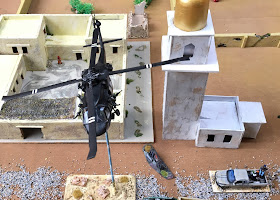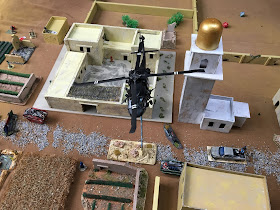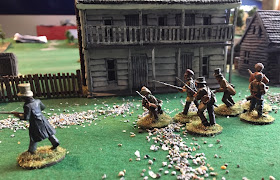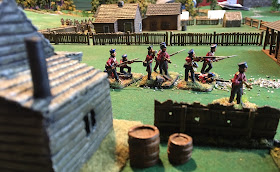
A Wargames Scenario
Today’s game, as the leading graphic indicates, was a War of 1812 game set in the Niagara front. I have played a little loose with the historical background, as those familiar with the campaign will note, and the tabletop terrain stretches reality even further. That said, here is the background and technical limitations of the game.
Background (with apologies to historical accuracy)
On 19 December 1813 Fort Niagara fell to the British and its recovery became a focus for the US military on the Eastern Great Lakes for the next year. All attempts to take it from the south and east were foiled, but in the late summer of 1814 a new plan was conceived.
This plan involved gaining control of the Western, or Canadian, bank of the Niagara River. Success here would make the capture of Forts George and Erie at the northern and southern ends, respectively, of the Niagara River an easier task. Not only would this isolate Fort Niagara, but it would give the Americans complete control of Lake Erie and would open up the possibility of operations in Lake Ontario against the key Canadian settlements of Hamilton, York (modern day Toronto) and Kingston, effectively closing the Great Lakes to the British.
Major-General Jacob Brown’s American Division was charged with the operation. Major-General Phineas Riall commands the British forces in the area.
The Briefings
United States Forces
What you know of the British positions:
- The main British forces are in camp south at Queenston
- The British have a small force a the blockhouse at the bridge over the Chippewa River
- Fort Erie is occupied by a militia force and is in a poor state of supply
- There is a British allied Indian village somewhere on the woods to the west.
Troops Available
West Division: Major General Jacob Brown
Scott’s Brigade – 9th, 15th, 22nd & 25th US Infantry, 1 battery
Ripley’s Brigade – 1st, 8th & 18th US Infantry, 4th Regiment Maryland Volunteer Infantry and 1st Rifles, 1 battery
Porter’s Brigade – 5th, 14th &16th US Infantry, 5th Regiment Maryland Volunteer Infantry, two units of Indians 1 battery
Unassigned – 23rd US Infantry, 1 battery, 2 squadrons of light dragoons
Objective
In order of importance the US forces need to:
- Capture Ft Erie
- Establish a position north of the Chippewa by securing the blockhouse and bridge
- Contain the Indian threat.
Game Details
- No British troops are deployed on the table at the start of the game.
- The American forces have the initiative.
- Indians in the open move normally. In woods they move from woodlot to woodlot, but if they cannot be seen either they can move up to an additional two woodlots, ceasing movement as soon as they can be observed.
- Brigade and Army Morale rules do not apply.
- In addition to normal rally rules all units with a “Rally” activation result can remove all losses at the beginning of their next player turn but:
- Must not be engaged in any activity
- Will lose one full stand
Table plan and arrival options.
British Forces
You know:
A US force consisting of up to 12 infantry regiments (mixed regulars and militia), 4 guns, some cavalry and some Indians is on the eastern bank of the Niagara River ready cross. The crossing point is unknown.
Your Forces
At Fort Erie
An understrength militia battalion plus 1 gun
At the blockhouse across the Chippewa River Colonel Scott
1 battalion 103rd Foot, 1 battalion Upper Canada militia, 1 gun
At the Camp south of Queenston
1st Brigade
1 battalion 13th Foot
1 battalion 44th Foot
2 Battalions West India Regiment
2 Battalions Canadian Voltiguers
2 batteries
2nd (Light Brigade)
2 squadrons 19th Light Dragoon Regiment
1 battalion 1st Foot
1 battalion 5th Foot
2 Battalions Glengary Light Infantry
1 battalion Royal Marines
2 batteries
Indians – Any point within 600mm of their village
2 units (increases to 4 if the US forces attack the village)
Objectives
- Destroy the American forces, or contain them south of the Chippewa
Special rules that differ from those for the US forces
- Troops in the blockhouse are not detectable until the Americans come within 600mm or when they fire the first time
- Fort Erie garrison and the Indians are controlled by the umpire.
- No British troops can move until an alarm is raised – and can only be raised if US troops are sighted by ANY British unit, except the troops at Fort Erie.
Table plan and possible US arrival options.

Game Details unknown to both sides
The Fort Erie militia will surrender if no British troops are visible and the Americans troops advance to within 500mm of the fort or fire on it.
Also unknown is that a unit of Canadian militia cavalry is in the fort and will ride out of the fort as soon as any American troops are visible to the fort and will ride north to join the British main force, but will not attempt to fight unless attacked. Once the have arrived at the British position they must rally for one full turn and are then available to the British commander.
If the game is stalling because of a lack of troops the umpire can make up to two more battalions available as reinforcements to either side.
General Details
Rules
The rules used in the game can be found here
Terrain
- The terrain is gently rolling.
- One southern end of the table is the outer works of the British Fort Erie.
- At the northern end is a British camp.
- The eastern side of the table, near the Niagara, is largely open with a couple of small farms. A road runs the full length of this side.
- The rest of the terrain is largely wooded.
- Two thirds of the way up the table on the eastern side is a blockhouse defending a bridge over the Chippewa River that flows into the Niagara.
- The Chippewa is fordable to infantry and cavalry at any point 500mm west of the bridge. To cross river non-Indian troops must halt at the river edge spend the next turn in the river and are disordered and on the beginning of the next turn may will be on the opposite edge and are free to move normally but disordered for the rest of the turn (unless they stand still on the edge). British indians can cross at any point simply deducting 100mm from their move.
- Half way up the table on the western side is an Indian village, located on a stream that flows into the Chippewa.
So how did the game run?
Well not at all like I expected it to.
The day dawned a bit overcast, maybe 6 degrees C. After a good breakfast we were at the table at 9:15.

The Americans chose not to exercise the option to come on across the Chippewa and brought all three brigades on the table on the middle deployment zone.

The British then placed all their troops in camp and we started play. The Americans chose to press Scott’s brigade towards the fort while Porter and Ripley were charged with pressing towards the blockhouse.


On turn two the gun in the blockhouse opened fire and the British at Queenston assembled. They moved with alacrity and quickly began to form a strong position. When their guns opened the Americans quickly realised that they were not going to get across the bridge easily and withdrew to reassess, forming around the farm. The British then established a line to the west of the bridge, fearing a flanking movement.


Meanwhile Scott approached the fort and the Canadian militia cavalry, not wanting to be a part of the surrender, rode north. Soon after the militia garrison sighted the Americans and surrendered.

Scott then turned back towards the bridge and encouraged by his success the Americans turned back towards the river. Ripley formed ready to storm across the bridge, it was going to be costly, but he should have been able to establish a position on the other bank, but the British 103rd stole a march and formed a line that would prevent their crossing. The Americans withdrew again and Scott moved back towards the fort intent on marching down the narrow valley towards the indian village. An extended fight then erupted between the two indian forces in the woods.


In time this advance was a success. Scott cleared the valley, even though an attack on the village brought out another two Indian units.
The British, realizing that the best success was gained by forming in front to Queenston and fell back, abandoning the blockhouse.
The game ended as a draw with a slight advantage to the Americans.


























